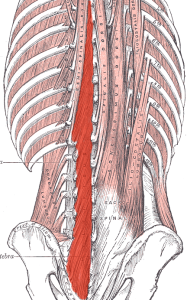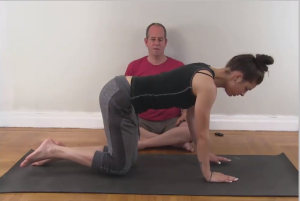 Living an upright life requires good tone in certain muscles that tend towards poor tone.
Living an upright life requires good tone in certain muscles that tend towards poor tone.
In general, I am talking about the muscles of the back but in particular, the muscles that run up and down the trunk along the spine.
At the bottom of this post, I’ll share an exercise that is also a test for one of these incredibly important muscles, the multifidus.
We need stronger backs. We tend towards tight, weak backs and we need to change our posture to lengthen and strengthen the muscles of the posterior trunk.
While not everyone is tight—there are as many people with loose muscles as tight muscles—most people are not as strong as they could be.
Many people are building muscles in a way that might not serve them best, even if they exercise regularly
Regardless of whether someone is long and weak or short and weak, the problem with our back muscles stems from a majority of the population leaning backward through life compressing the lower back and failing to take advantage of what should be a supported extension of the spine.
Good posture refers to bones that are stacked and aligned one on top of the other so that the weight and support of the body passes through the skeleton from top to bottom.
Deviation from this puts a great deal of strain on the connective tissues—muscles, ligaments, tendons, fascia—that support the bones.
Believing that everyone leans backward often takes a leap of faith and a change of perspective.
Find some quiet time today to watch people on the street, or in line in a store.
You might begin to see that a lot of people let their legs go forward and their upper body lean backward.
Once you start to notice this pattern you will see it everywhere.
This habitual rearward bend both compresses the lower spine and shortens the muscles of the lower back— the multifidus, quadratus lumborum, and the erector spinae.
The erector spinae runs up the spinal column but if they can’t align and function correctly at their base there isn’t much hope for their efficacy at the top.
All the exercise in the world won’t help these muscles if bad posture in both standing and sitting keeps them short and tight.
We stand and sit way more than we exercise and we tend to mirror our posture with the way we exercise more often than we change it.
I teach people to walk, stand, and sit in a new way to bring permanent change to these tight lower back muscles but the change must begin with an acknowledgement that they are a problem.
This concept doesn’t seem to be on most people’s radar as any instruction to stand up straight or improve one’s posture is most often met with the aforementioned lifting of the rib cage, throwing the arms back, and increasing the tightness of these lower back muscles.
Multifidus Test
- Come on to your hands and knees.
- Make sure the thighs and shins are parallel directly under the hips. The ankles want to be straight so you can’t cheat with your feet if they turn in. And your wrist should line up in a straight line with your pinkies not spread too wide.
- Take the right hand and left knee a half inch off of the floor. Try not to go sideways to backwards. Just up a tiny bit.
- Switch sides.
Pay attention to the difference in the two sides. One is always going to be a little more stable that the other but hopefully there won’t be too much contrast between the two.
This is a basic test to see if the multifidus muscle goes into action when called upon to do so. The less you waver the more tone the muscle has.
***

